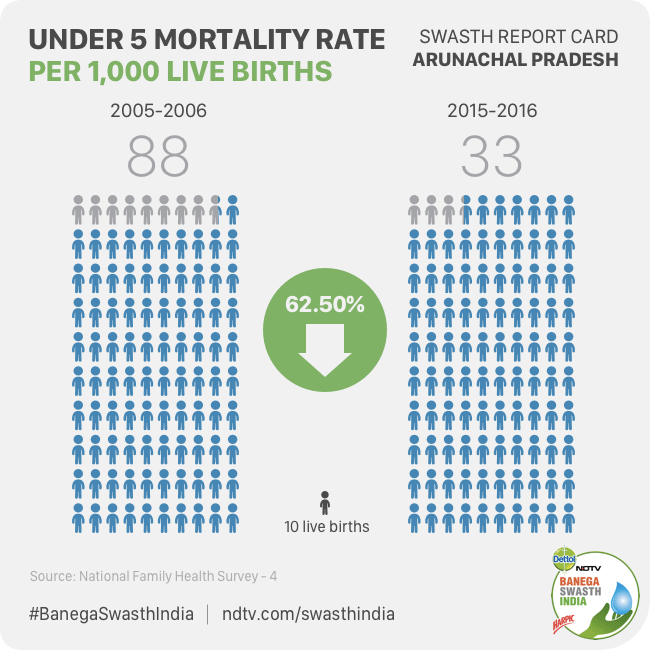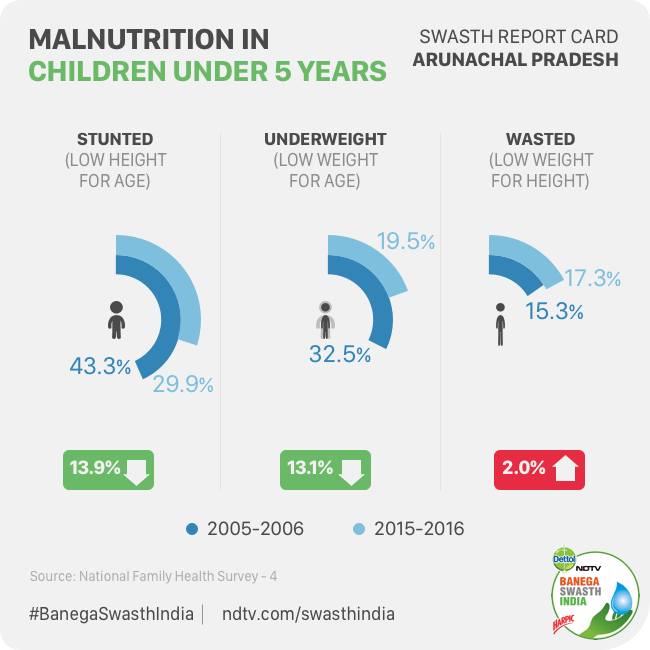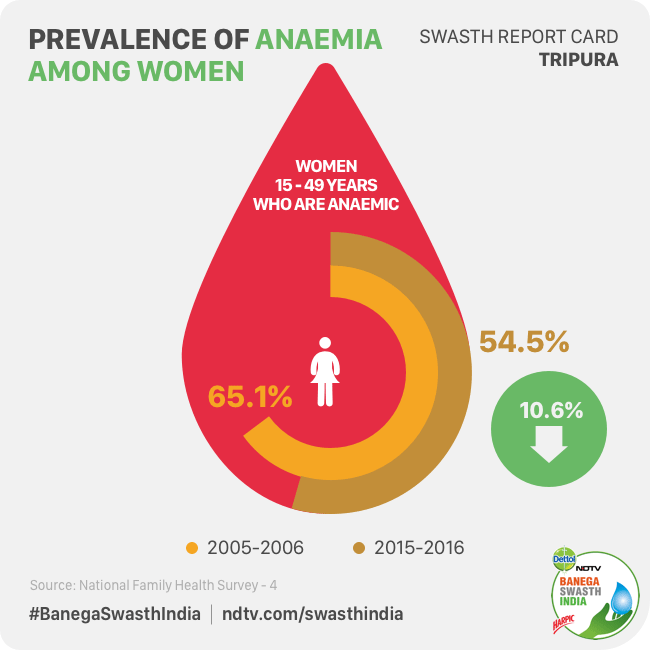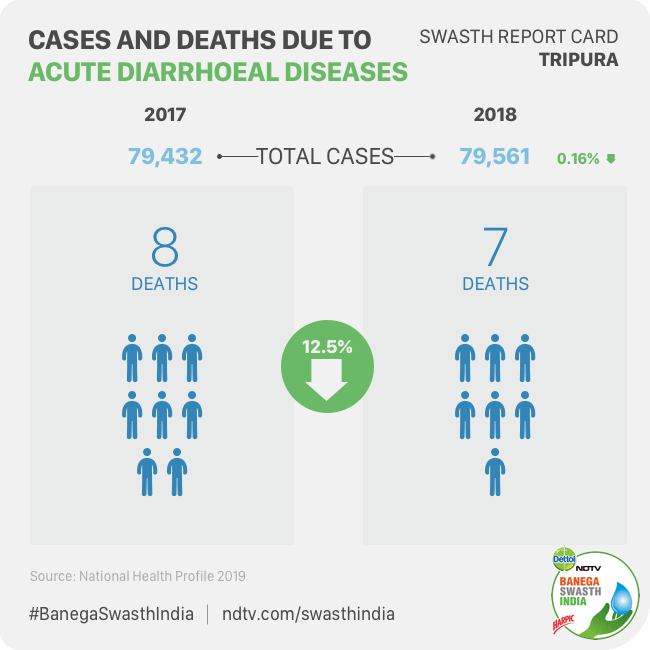New Delhi: The fourth and latest national family health survey (NFHS-4) reveals that Northeastern states of India – Assam, Arunachal Pradesh, Nagaland, Manipur, Meghalaya, Mizoram, Sikkim and Tripura, have made progress in health indicators like mortality among infant and children, and prevalence of malnutrition and anaemia. While there are several policies being implemented by both Central and State governments to boost the healthcare delivery in the region, difficulty in transportation and communication due to the tough hilly terrain poses a hindrance to further development of healthcare in the Northeastern region. According to a senior official at the Ministry of Health and Family Welfare (MoHFW), the major problems related to the health sector in the northeastern states include a shortage of trained medical manpower, difficulty in providing immediate healthcare to the population located in far flung areas, and making effective and timely utilization of existing medical facilities. These are also the cause of high instances of Diarrhoea in the region, as per the official.
Also Read: Swasth Report Card: Rural Areas In Rajasthan Are Still Lagging Behind In Healthcare
The major programmes implemented by the government for maternal and child healthcare in the Northeast region are the National Rural Health Mission (NRHM) and the Integrated Child Development Scheme (ICDS). There has been an increase in the number of safe and institutional delivery because of NRHM and ICDS, says the official. Apart from this, Janani Suraksha Yojana (JSY), Accredited Social Health Activists (ASHA) at grassroots level, free ambulance services and Mobile Medical Unit are also some of the initiatives to improve health care in the northeast region.
Here’s a quick look at the health indicators of the Northeastern states:
Infant Mortality Rate- While Arunachal Pradesh Makes Maximum Improvement, Assam Continues To Struggle
Infant Mortality Rate (IMR) is the estimate of the number of deaths among children below the age of one year per 1,000 live births. While the country has a high IMR of 41, the northeastern states are collectively performing better than the national figure. According to NFHS, IMR is also a reflection of the status of healthcare facilities in the region.
In Assam the infant mortality rate, as reported by NFHS-4 (2015-16) is 48 deaths per 1,000 live births, which is 27.2 per cent down from the NFHS-3 (2005-06) findings of 66 deaths per 1,000 live births. The state is performing worse than the national average which is 41. The infant mortality in rural areas (50 deaths per 1,000 live births) in the state is much higher than in urban areas (28 deaths per 1,000 live births). Arunachal Pradesh (AP), on the other hand, was able to reduce the IMR significantly by almost 62 per cent. AP has outperformed the national efforts. While the country could avert only 28 per cent of infant deaths during the period between NFHS 3 and 4, AP brought down the IMR by more than 60 per cent.
The infant mortality rate in Nagaland in NFHS-4 is estimated at 30 deaths before the age of one year per 1,000 live births, down from 38 in NFHS-3. The survey found that in the state, the infant mortality rate is higher for children whose mothers have no schooling (33 per 1,000 live births) or less than 10 years of schooling (30 per 1,000 live births) than for children whose mothers have completed 10 or more years of schooling (25 per 1,000 live births). Nagaland is also performing better than the national average in terms of IMR. Manipur is doing even better than Nagaland, AP and the national average as the IMR reported under NFHS 4 stands at 22 per 1,000 live births. This is down by almost 27 per cent from the NFHS-3 estimate of 30. The report highlights that infant mortality is much higher in rural areas than in urban areas.
The infant mortality rate in Meghalaya in NFHS-4 is estimated at 30 deaths before the age of one year per 1,000 live births, down by about 33.33 per cent from the NFHS-3 estimate of 45. The state has also outperformed the nation which stands at IMR 41.
Bucking the trend for Northeastern states, The infant mortality rate in Mizoram in NFHS-4 is estimated at 40 deaths per 1,000 live births. This is an increase of 15 per cent from the NFHS-3 which reported IMR as 34 in 2005-06.
The infant mortality rate in Sikkim in NFHS-4 is reported at 30 deaths before the age of one year per 1,000 live births, down from the NFHS-3 estimate of 34. For Tripura also, NFHS-4 estimated IMR at 27 per 1,000 live births, which is down by almost half (47 per cent) from the NFHS-3 estimate of 52. Sikkim is also performing better than the national average like Arunachal Pradesh and Nagaland.
Mizoram, A Winner On Under-Five Child Mortality Rate
According to the United Nations Development Programme (UNDP), Under Five Child Mortality Rate (U5CMR) represents the probability of dying by the age of five per 1,000 live births. While the country has a U5CMR of 50 per 1,000 live births, most states in the Northeast part of the country are performing better than the national average. Mizoram, which has the highest literacy rate among the Northeast is also the best performing states among the eight in terms of U5CMR. According to NFHS 4, U5CMR of Mizoram was 12 which was a reduction of about 8 per cent from 20 in NFHS 3.
Among other states, Assam has made progress by reducing U5CMR NFHS 4 Under-five mortality in the state by more than 34 per cent from 85 deaths per 1,000 live birth in 2005-06 to 56 in 2015-16, as reported by NFHS 4. The state is also performing better than the nation as the whole. In Nagaland, Under-5 mortality has also come down substantially to 37 from 65 per 1,000 live births since NFHS-3. Similarly, Arunachal Pradesh has seen a significant decline of 62.5 per cent from 88 in NFHS 3 to 33 in NFHS 4. U5MCR has decreased by about 7 per cent from 35.6 per 1,000 live births in 2005-06 to 28.9 in 2015-16. Meghalaya has also shown a downward trend from 70 in NFHS 3 to 40 in NFHS 4. Sikkim that stands at 32 and Tripura that stands at 24 has also seen a significant decline in U5CNR between NFHS 3 and 4.
Also Read: Swasth Report Of West Bengal: Anaemia In Women And Children Needs Attention
Downward Trends In Malnutrition Parameters In All Northeastern States
Malnutrition is a condition in which there is a deficiency or excess of nutrition. Children suffering from malnutrition have weak immunity, are susceptible to long term developmental delays, and face an increased risk of death. The kinds of malnutrition most prevalent among children are stunting (low height for age), wasting (low weight for height) and underweight (low weight of age).
In Assam, 36 per cent of children under age five years are stunted, too short for their age, which indicates that they have been undernourished for some time. Seventeen per cent of children are wasted, too thin for their height and 30 per cent are underweight. According to the data reported by NFHS 4, children’s nutritional status in Assam has generally shown an improvement since NFHS-3. Stunting decreased by 10 per cent in the 10 years between NFHS-3 and NFHS-4, and the percentage of children who are underweight decreased by 7 percentage points. The proportion of wasting increased marginally by 3 per cent (from 14% to 17%).
In Arunachal Pradesh, 29 per cent of children under age five years are stunted, 17 per cent are wasted, and 19 per cent are underweight. Arunachal Pradesh has improved substantially since NFHS-3 by some measures. While stunting decreased from 43 per cent to 29 per cent in the 10 years between NFHS-3 and NFHS-4, the percentage of children who are underweight decreased from 33 per cent to 19 per cent, in the same period. But wasting increased slightly (from 15 per cent to 17 per cent). In AP, as per NFHS 4, girls are doing slightly better than boys on all the indicators of malnutrition.
Nagaland has 29 per cent of children under age five years who are stunted, 11 per cent are wasted, and 17 per cent are underweight. The state has seen an improvement in stunting from 39 per cent to 29 per cent in the 10 years between NFHS-3 and NFHS-4, and the percentage of children who are underweight decreased from 25 per cent to 17 per cent. IN the same period, wasting also decreased slightly from 13 per cent to 11 per cent.
In Mizoram, 28 per cent of children under age five years are stunted, 6 per cent of children are wasted, and 12 per cent are underweight. Children’s nutritional status in Mizoram improved since NFHS-3 on all three parameters of Malnutrition. Stunting decreased by 12 per cent, from 40 per cent to 28 per cent, in the 10 years between NFHS-3 and NFHS-4, and the percentage of children who are underweight decreased by 8 percentage points, from 20 per cent to 12 per cent. Wasting decreased by 3 per cent (from 9 per cent to 6 per cent).
In Manipur, 29 percent of children under age five years are stunted, about 7 per cent children are wasted, and 14 per cent are underweight. Like Mizoram, the state of Manipur has also improved the nutritional status of its children since NFHS 3. Stunting decreased from 36 per cent to 29 per cent in the 10 years between NFHS-3 and NFHS-4. The percentage of children who are underweight decreased from 22 per cent to 14 per cent and the proportion of wasting among children under age five has decreased marginally by two per cent (from 9 per cent to 7 per cent).
In Meghalaya over 40 per cent of children are stunted, 1 per cent are wasted and about 29 per cent are underweight. In the period between NFHS 3 and 4, stunting in Meghalaya decreased from 55 per cent to 44 per cent, and the proportion of children who are underweight decreased from 49 per cent to 29 per cent. However, wasting has increased by 15.3 per cent, in the same period.
In Sikkim, 30 per cent of children under age five years are stunted, 14 per cent are wasted, and 14 per cent are underweight. In the period between NFHS 3 and 4, stunting decreased from 38 per cent to 30 per cent, and the proportion of underweight children dropped from 20 per cent to 14 per cent. However, in the same period, wasting increased slightly (from 10 per cent to 14 per cent).
In Tripura, about 24 per cent for children under 5 are stunted, 17 per cent are wasted and, about 24 per cent are underweight. Children’s nutritional status in Tripura has improved since NFHS-3 on all three nutritional status measures. Stunting decreased from 36 per cent to 24 per cent in the 10 years between NFHS-3 and NFHS-4, the percentage of children who are underweight decreased from 40 per cent to 24 per cent; and wasting decreased from 25 per cent to 17 per cent.
Anaemia Among Children And Women Is High In All Northeastern States
Anaemia is a condition that is marked by low levels of haemoglobin in the blood and the deficiency of Iron is estimated to be responsible for most cases of anaemia but as per health experts, the condition can also be caused by malaria, nutritional deficiencies, infections, and genetic conditions. Anaemia is a major health problem in most Northeastern states.
In Assam, about 36 per cent of children below age five and 46 per cent of women in the age group 15-49 years are anaemic in the state. As per NFHS, children of mothers who have anaemia are much more likely to be anaemic. In a bid to tackle anaemia, Assam government has introduced ‘Mission Tejaswee’- a policy for the eradication of anaemia, and Adoroni, an ambulance facility to ferry pregnant women and newborn to and from health institutions.
In Nagaland, more than one-fifth (26 per cent) of children age 6-59 months and about 28 per cent of women who are 15-49 years old are anaemic. In Mizoram among children between the ages of 6 and 59 months, 19 per cent are anaemic and about one-fourth of the women have anaemia.
Similarly in Manipur, Meghalaya, Sikkim and Tripura, 23.9 per cent, 48 per cent, 55.1 per cent, and 48.3 per cent of total children of the respective states are suffering from anaemia.
Also Read: Swasth Report Of Maharashtra: Malnutrition Remains Leading Health Problem Among Children Under Five
Diarrhoea- Major Concern
According to the National Health Profile (NHP) 2019 report developed by the Ministry of Health and Family Welfare of the Government of India, Diarrhoea is a major health concern in the Northeast states. Assam saw a rise of more than 83 per cent in Diarrhoeal Deaths in the past one year and a rise of more than 40 per cent in the number of Diarrhoeal disease cases. In Arunachal Pradesh, however, there was a decrease of 50 per cent in Diarrhoeal Deaths in the same period while just a slight improvement in the prevalence of the disease and its cases. Other states – Nagaland, Manipur, Meghalaya, Mizoram, Sikkim and Tripura saw just a slight decline in the number of cases of Diarrhoea. Northeast is collectively responsible for about 4.24 per cent to the total number of Diarrhoea cases in the country which was almost 1.3 crore (1,31,94,775) in 2018.
Note: For the National Family Health Survey (NFHS) 4, information for the eight states of Northeast India was gathered from the sample as shown in the table below:
Table: Sample size for NFHS 3 and NFHS 4 for the Northeastern states
| State | NFHS 3 | NFHS 4 | ||||
| Total Households | Women | Men | Total Households | Women | Men | |
| Assam | 3,437 | 3,840 | 1,394 | 24,542 | 28,447 | 3,860 |
| Arunachal Pradesh | 1,526 | 1,647 | 711 | 14,617 | 14,294 | 1,930 |
| Nagaland | 3,866 | 3,896 | 3,971 | 11,213 | 10,790 | 1,440 |
| Manipur | 3,498 | 4,512 | 3,951 | 11,724 | 13,593 | 1,747 |
| Meghalaya | 1900 | 2,124 | 720 | 7,327 | 9,202 | 1,144 |
| Mizoram | 1,513 | 1,791 | 665 | 11,397 | 12,279 | 1,617 |
| Sikkim | 1,902 | 2,127 | 810 | 4,662 | 5,293 | 801 |
| Tripura | 1,574 | 1,906 | 711 | 4,510 | 4,804 | 821 |


























